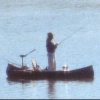WOW - a lot of technology in that little unit for sure...but the trade-off is the small 3.5" screen. However, if you're sitting in the yak and have the unit rigged right next to you, you'll be pretty close to that screen.
For me, screen size has always been a major factor since I am standing the entire time I'm fishing so I have to look down a ways to the sonar screen.
For the OP, if GPS is a "must-have" then you would be going quite a ways over your budget to get there with the HB Helix 5. Regarding your questions about the technology - follow Wayne P's advice and checkout the screenshots thread pinned to the top of this forum - lots of images there of the different views. Briefly, 2D sonar gives you your depth, bottom contours, sometimes bottom composition (if you are experienced in reading the image), and will show fish as "fish arches". Down-imaging gives you an almost TV like view of what's under the boat including logs, brush, submerged trees, fish, etc. Side-imaging shows whats on each side of the boat wit a detail similar to down-imaging. As to how much of the technology that you want or need - that's up to you to decide. BUT, since prices have come down so much for this stuff you might want to consider getting at least down-imaging and you've already decided you want GPS so that might be your starting point when looking at units.
ALSO, if you haven't researched it yet, start thinking about how you want to rig a sonar unit on your boat. There have been a number of threads in this forum about kayak mounting you can check out.









